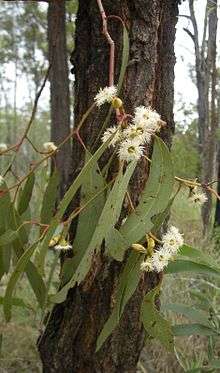Eucalyptus fibrosa
| Red Ironbark | |
|---|---|
 | |
| E. fibrosa | |
| Scientific classification | |
| Kingdom: | Plantae |
| (unranked): | Angiosperms |
| (unranked): | Eudicots |
| (unranked): | Rosids |
| Order: | Myrtales |
| Family: | Myrtaceae |
| Genus: | Eucalyptus |
| Species: | E. fibrosa |
| Binomial name | |
| Eucalyptus fibrosa F. Muell. | |
Eucalyptus fibrosa, commonly known as the Red Ironbark or Broad-leaved Red Ironbark, is a type of Ironbark tree found in eastern Australia, mainly in Queensland and New South Wales. This plant is in family Myrtaceae.
It was originally described by Victorian state botanist Ferdinand von Mueller in 1859 from a collection from the Brisbane River. Two subspecies are recognised -
- Eucalyptus fibrosa nubila - Blue-leaved ironbark.
- Eucalyptus fibrosa fibrosa.
The tree grows to a height of about 35 meters (115 feet) and a spread of around 10 m (33 ft) The trunk has deeply furrowed dark gray bark. The alternately arranged lanceolate leaves are dark grey-green and broader than other ironbarks, measuring 12–18 cm (4.7–7.1 in) long and 2.5–5 cm (0.98–1.97 in) wide. They are on petioles 1.5–2.7 cm (0.59–1.06 in) long. The flowers are creamy white. The dense, strong wood is valued for lumber. The sap, locally called "kino," was used by natives to keep fish lines from fraying and by the early settlers for ink.

Eucalyptus fibrosa is found in Queensland and New South Wales south to Moruya and extending west to the Central Tablelands, North Western Slopes, and Central Western Slopes. It grows in sclerophyll forest on clay soils.
Cultivars are available for planting. It is a bird attracting plant in gardens and parks,[1]
See also
- Eucalyptus
- Eucalyptus crebra, Narrowleaf red ironbark.
References
- ↑ "Broad-leaved Ironbark". Birds In Backyards. Sydney, NSW: Australian Museum. 29 August 2005. Retrieved 2 February 2010.